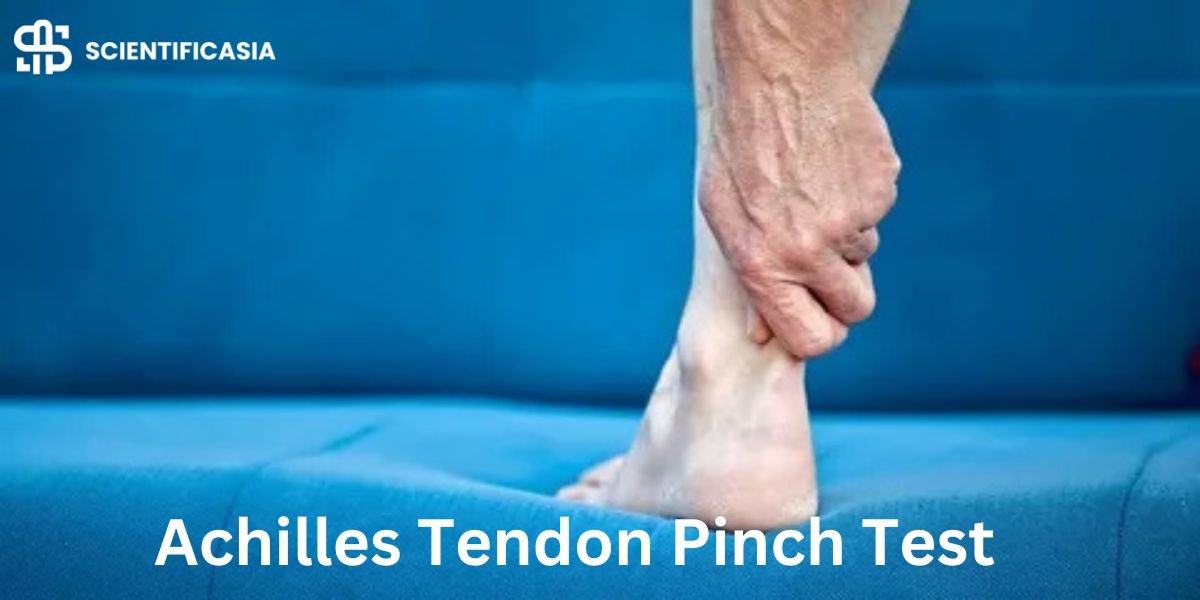The Achilles tendon pinch test is one of the most important diagnostic tools available to medical experts for identifying Achilles tendon injury. This straightforward yet efficient physical examination method can provide important information about the health and performance of one of the body’s most important tendons. The sore Achilles tendon pinch test carries sensitivity that both athletes and medical professionals should understand, as it can identify potential issues before they expand.
The purpose of the Achilles tendon rupture test is to determine whether the tendon is painful or uncomfortable, as this might be an indication of underlying conditions such as tendinopathy or tears. Athletes who regularly participate in high-impact sports should pay special attention to this exam.
This article will cover the methods, importance, and common problems the heel spur Achilles tendon pinch test can detect in detail. Understanding the importance of the signs your Achilles tendon is about to rupture is crucial for protecting peak performance and avoiding injuries.
Where is the Achilles Tendon? The Role & Overview
The Achilles tendon, which connects the calf muscles to the heel bone (calcaneus), is the biggest and strongest tendon in the human body. The Achilles tendon is made up of the tendons of the soleus and gastrocnemius muscles.
The Achilles tendon is essential in movements like walking, running, and jumping. Its strength and elasticity facilitate the transfer of force from the calf muscles to the foot, hence enabling movement. However, overuse or stress can make the Achilles tendon prone to damage, including partial or full ruptures. The pinch test or calf squeeze test is a popular method for identifying symptoms of damage to this critical tissue, helping the patient to take appropriate measures to maintain its health.
What is the Achilles Tendon Pinch Test?
An investigation known as the Achilles tendon pinch test involves softly pinching the tendon at several locations. This simple test can identify the specific uncomfortable or soft locations, which could be a sign of tendon inflammation, rips, or other issues. The Achilles tendon rupture test is a useful early-warning method to identify Achilles tendon issues since it is relatively simple to detect soreness or irregularities by lightly pinching or pushing along the tendon.
This test is essential for physical therapists, sports medicine specialists, and podiatrists since it provides direct information on how to diagnose tendon disorders without the need of highly specialized equipment. The results of the pinch test may indicate the need for additional examinations. Such an MRI or ultrasound may be necessary if any doubt persists.
How to Perform the Achilles Tendon Pinch Test
A qualified medical professional usually performs the Achilles tendon pinch test in a clinical environment. Here is an overview of the process:
- Proper Positioning: To get better access to the Achilles tendon, instruct the patient to sit or lie down in an appropriate position with the affected leg relaxed.
- Detecting the Tendon: The doctor or nurse finds the Achilles tendon, which is at the back of the heel and goes up the leg.
- Putting Pressure on Effected Tendon: To measure for any places that can produce discomfort or sensitivity, the physician uses his fingers to pinch or push along different spots of the tendon. Patient feedback must be considered as quite helpful at this time.
- Analysis of Pain: This may include discomfort or soreness that the patient mentions, which might indicate conditions including tendinitis or tendon degeneration.
Every aspect of the Achilles tendon pinch test provides information on the tendon’s status, allowing healthcare providers to evaluate whether other tests or treatments are required.
Achilles Tendon Rupture Symptoms
Doctors perform a clinical test known as the Achilles tendon pinch test to determine the Achilles tendon’s integrity and identify any potential injuries or illnesses that might be impacting it. So, you can better take care of your health and seek the right medical assistance if you are aware of the signs your Achilles tendon is about to rupture through this test. The following list includes the common and rare signs & symptoms that might appear before or during the sore Achilles tendon pinch test.
Common Achilles Tendon Rupture Symptoms:
- Pain or discomfort: Patients frequently describe localized pain in the back of the heel or in the tendon itself. This pain might be extreme or mild, and it increases with movement.
- Swelling: During palpation, you can detect visible swelling due to inflammation surrounding the Achilles tendon.
- Tenderness: An irritated or injured Achilles tendon may feel sensitive to the touch.
- Stiffness: Individuals may report tendon stiffness, especially in the morning or after extended inactivity.
Rare Symptoms:
The heel spur Achilles tendon pinch test may also be associated with the following additional, less common symptoms:
- Crepitus: When moving the ankle, you may feel a grating or crackling sensation, which could be an indication of an Achilles tendon injury or degeneration.
- Weakness: When trying to push off the foot, some people may experience a loss in strength, which can impact their flexibility and athletic performance.
- Radiating Pain: Pain that radiates up the calf or down the heel could indicate damage to nearby structures.
- Changes in Gait: Individuals suffering from pain or weakness may alter their walking style, resulting in compensatory motions that might cause more discomfort.
Early detection of these symptoms is crucial since they may be signs of Achilles Tendinitis, Tendinosis, or a Partial Tear. It is best to speak with a healthcare provider for a thorough assessment and suitable treatment options if you encounter any of these symptoms after doing the Achilles tendon rupture test. Early management may greatly improve recovery results and avoid future problems.
What Causes Achilles Tendon Rupture?
Understanding what causes an Achilles tendon pinch test to be positive is important for diagnosing and treating the problem correctly. Here are a few possible reasons:
- Achilles Tendinopathy: One of the most common causes of a positive pinch test is Achilles tendinopathy. Overuse causes Achilles tendon degeneration, leading to discomfort, stiffness, and edema. Repetitive strain on the tendon is a common problem for athletes, especially runners.
- Achilles Tendon Rupture: A positive pinch test may indicate a whole or partial Achilles tendon rupture. This Achilles tendon injury usually happens when you move quickly, like when you jump or run. It feels like a sharp pain in the back of your ankle.
- Insertional Tendinopathy: This disorder affects the Achilles tendon’s attachment point to the heel bone. The insertion site may experience discomfort and inflammation due to repetitive stress. This disease may be more common in those with high arches or flat feet.
- Bursitis: Inflammation of the bursa, a small fluid-filled sac that reduces tissue friction, can cause discomfort and soreness in the Achilles tendon. When it happens at the back of the heel, retrocalcaneal bursitis can be very painful and may show up as a positive pinch test.
- Calcaneal Apophysitis: Teenagers frequently experience calcaneal apophysitis, an ailment that causes inflammation of the heel’s development plate. It may result in Achilles tendon soreness and tenderness, which would make the pinch test positive.
- Systemic Conditions: Some systemic disorders, such as gout or rheumatoid arthritis, can impact the Achilles tendon and associated tissues, causing discomfort and inflammation. Such conditions can also lead to a positive pinch test result.
- Biomechanical Problems: Abnormal foot mechanics, such as overpronation or supination, may overstress the Achilles tendon. The pinch test is a helpful diagnostic technique since it can result in tendinitis or other forms of injury.
- Old Injuries: People who have experienced ankle sprains or Achilles tendon injuries in the past may be more likely to have additional issues, such as tendinopathy or rupture, which the pinch test can identify.
You may take proactive measures to avoid or treat Achilles tendinitis, by being aware of its causes and risk factors. If you notice any signs your Achilles tendon is about to rupture, you should seek medical attention for an appropriate diagnosis and treatment plan.
Achilles Tendon Treatment Options
If you’re experiencing pain after a sore Achilles tendon pinch test, it’s important to try a few different things until you find what works best. This section describes home remedies, alternative therapies, and conventional treatments that can aid in pain relief and recovery.
Traditional Treatments
Most of the time, preventative methods are the first step in traditional treatments for Achilles tendon rupture. Some typical methods are as follows:
- Rest and Activity Modification: During the initial stages of treatment, it is crucial to cease activities that exacerbate symptoms and allow the tendon to rest. Resuming activities gradually and modifying them to decrease stress on the tendon might help the healing process.
- Pain treatment: Under a doctor’s supervision, use pain management methods including cold therapy and nonsteroidal anti-inflammatory medications (NSAIDs) like naproxen or ibuprofen. Applying ice packs to the affected area for 15 to 20 minutes several times a day can reduce pain and inflammation. We could also recommend using orthotic devices to provide support and alleviate pressure on the tendon.
- Physical Therapy: When it comes to Achilles tendonitis recovery, physical therapy is essential. A skilled physical therapist can walk you through exercises and stretches to help strengthen the muscles and tendons that surround the Achilles tendon. These workouts enhance general function, stability, and flexibility.
- Orthotics: Custom shoe inserts can assist in the correction of biomechanical issues and are beneficial toward the Achilles tendon’s support.
Alternative Therapies
Alternative treatments may provide additional assistance to individuals seeking alternative methods.
- Acupuncture: This ancient Chinese medical treatment targets specific points on the body to help relieve pain and promote healing.
- Massage Therapy: Relaxing massage relieves stress in the Achilles tendon and calf muscles and increases blood flow.
- Chiropractic Care: A chiropractor can assist in correcting the body and improving general biomechanics, potentially lowering Achilles tendon stress.
Home Remedies
In addition to expert care, many natural therapies can help minimize signs and symptoms.
- Epsom Salt Soaks: You can ease muscular tension and minimize edema by soaking your feet in warm water filled with Epsom salts.
- Turmeric: Known for its anti-inflammatory qualities, turmeric can help lower pain whether taken as a herbal remedy or added to food.
- Compression: Applying a compression bandage to the affected area will help reduce swelling and support it.
It’s essential to speak with a healthcare provider while thinking about Achilles tendon treatment alternatives to decide on the best course of action for your particular situation. Many of these therapies are available through professional services like physical therapy clinics, alternative healthcare professionals, or neighborhood pharmacies and health food stores. You may take charge of your recovery and restore flexibility by considering these different therapy options.
Advanced Surgical Techniques
If alternative treatments fail to relieve the pain or if the Achilles tendon completely ruptures, surgery may be necessary. Surgical treatment for Achilles tendinitis can take the following forms:
- Open Surgery: This conventional method immediately accesses the injured tendon by creating an incision in the rear of the leg. The surgeon will next sew the tendon’s broken ends back together.
- Minimally Invasive Surgery: To repair the tendon, surgical techniques like percutaneous or endoscopic surgery require tiny cuts and the use of specialized tools. Comparing these methods to open surgery, there could be less scarring and a possible shorter recovery time.
Final Thoughts:
In conclusion, the Achilles tendon pinch test plays a crucial role in diagnosing injuries or other conditions affecting the tendon. Gaining knowledge of this exam can enable you to identify signs your Achilles tendon is about to rupture earlier, resulting in swift action and better recovery of Achilles tendon rupture.
By learning about the Achilles tendon partial tear test, you can take charge of your foot and ankle health. Do not be afraid to consult a doctor if you think you may have an Achilles tendon problem. Look into materials on tendon health, recovery activities, and preventive measures for more information. Understanding these factors can help you live a healthier, more active lifestyle, which is crucial for your well-being.
FAQs
Should I stretch my Achilles tendon if it hurts?
Stretching gently can be beneficial, but stay away from painful, forceful stretches. Always follow the advice of your doctor before doing anything.
Can Achilles tendonitis heal on its own?
Yes, with rest, ice, and stretching minor Achilles tendonitis may recover itself. In serious conditions, a doctor may need to provide further care.
What Happens If You Ignore Achilles Tendonitis?
Ignoring Achilles tendonitis symptoms can lead to chronic pain and an increased risk of tendon rupture. Injuries may adversely affect your capacity to carry out everyday tasks and result in long-term harm. To properly resist issues and guarantee a full recovery, doctors advise early treatment.
What does the Achilles tendon pinch test detect?
It finds anomalies in the Achilles tendon, such as inflammation or soreness.
Does the Achilles tendon pinch test hurt?
Although gentle, the heel spur Achilles tendon pinch test may cause minor pain, especially if there is an existing injury.
How often does an athlete receive an Achilles tendon pinch test?
Follow-up care may help players who play high-impact sports, especially if they are having trouble with tendon pain.
Can Achilles tendinitis be self-diagnosed?
Sometimes the person experiencing minor tendon pain can diagnose it, but it is always best to see a doctor to get the right diagnosis and treatment plan.
When to Consult a Healthcare Provider
While the sore Achilles tendon pinch test is a useful self-assessment technique for identifying potential Achilles tendon concerns, certain symptoms and conditions require medical attention. Difficulty in walking, chronic discomfort, and swelling might be signs of a serious Achilles tendon injury. Although the heel spur Achilles tendon pinch test is a useful diagnostic tool, further examination will sometimes be necessary to identify an accurate diagnosis. Early resolution of this problem reduces the likelihood of future painful treatments.
















